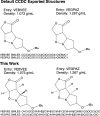Machine Learning Models for High Explosive Crystal Density and Performance
- PMID: 39618487
- PMCID: PMC11603605
- DOI: 10.1021/acs.chemmater.4c01978
Machine Learning Models for High Explosive Crystal Density and Performance
Abstract
The rate of discovery of new explosives with superior energy density and performance has largely stalled. Rapid property prediction through machine learning has the potential to accelerate the discovery of new molecules by screening of large numbers of molecules before they are ever synthesized. To support this goal, we assembled a 21,000-molecule database of experimentally synthesized molecules containing energetic functional groups. Using a combination of experimental density measurements and high throughput electronic structure and atomistic calculations, we calculated detonation velocities and pressures for all 21,000 compounds. Using these values, we trained machine learning models for the prediction of density, detonation velocity and detonation pressure. Notably, our model for crystal density surpassed the accuracy of all current models and decreased the root-mean square error (RMSE) of the previous best model by 20%. This improvement in model performance relative to past works is attributed to our handling of chiral-specified Simplified Molecular-Input Line-Entry System (SMILES) strings and introduction of a new molecular descriptor, MolDensity. To elucidate descriptor importance, we evaluated interpretable descriptors in terms of importance and compared the accuracy of a statistics-driven machine learning model against a model comprised of descriptors typically assumed to control material density. The inexpensive, yet highly accurate predictions from our models should enable creation of future artificial intelligence (AI) models that are able to screen large numbers (>106) of compounds to find the highest performing compounds in terms of crystal density, detonation velocity and detonation pressure.
© 2024 The Authors. Published by American Chemical Society.
Conflict of interest statement
The authors declare no competing financial interest.
Figures










References
-
-
Detonation parameters are well-established in the literature—for consistency these have been calculated with Cheetah thermochemical code.
-
-
- Sobrero A. Sur plusieur composés détonants produits avec l′acide nitrique et le sucre, la dextrine, la lactine, la mannite et la glycérine. Comptes Rendus 1847, 24, 247–248.
-
- Sabatini J. J.; Oyler K. D.. Recent Advances in the Synthesis of High Explosive Materials. Crystals 2016, 6 ( (1), 5.10.3390/cryst6010005. - DOI
-
- Klapötke T. M.Chemistry of high energy materials. In Chemie Der Hochenergetischen Materialien; Walter de Gruyter GmbH & Co KG, 2022.
-
- Nielsen A. T.; Chafin A. P.; Christian S. L.; Moore D. W.; Nadler M. P.; Nissan R. A.; Vanderah D. J.; Gilardi R. D.; George C. F.; Flippen-Anderson J. L. Synthesis of polyazapolycyclic caged polynitramines. Tetrahedron 1998, 54 (39), 11793–11812. 10.1016/S0040-4020(98)83040-8. - DOI
LinkOut - more resources
Full Text Sources
Miscellaneous
